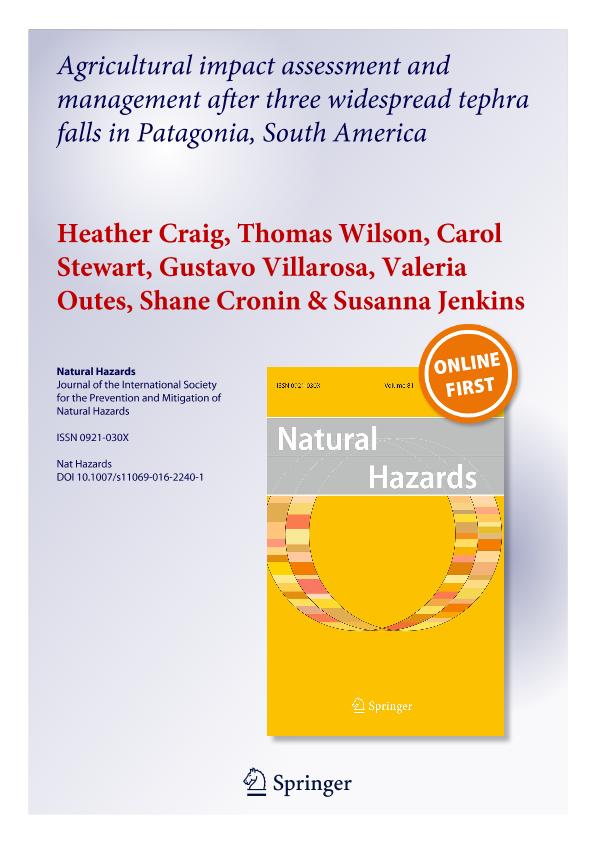Artículo
Agricultural impact assessment and management after three widespread tephra falls in Patagonia, South America
Craig, Heather; Wilson, Thomas; Stewart, Carol; Villarosa, Gustavo ; Outes, Ana Valeria
; Outes, Ana Valeria ; Cronin, Shane; Jenkins, Susanna
; Cronin, Shane; Jenkins, Susanna
 ; Outes, Ana Valeria
; Outes, Ana Valeria ; Cronin, Shane; Jenkins, Susanna
; Cronin, Shane; Jenkins, Susanna
Fecha de publicación:
06/2016
Editorial:
Springer
Revista:
Natural Hazards
ISSN:
0921-030X
Idioma:
Inglés
Tipo de recurso:
Artículo publicado
Clasificación temática:
Resumen
Agricultural production is often concentrated in volcanically active or previously active areas where weathered volcanic products form fertile soils. However, this proximity means agriculture is exposed to tephra fall hazards. The type and severity of impacts to agricultural systems from tephra fall are dependent on both the hazard intensity metrics (tephra fall characteristics, such as thickness, grain size) and the vulnerability characteristics of the exposed agricultural system(s). Understanding the relationship between significant intensity metrics of tephra fall hazard and farm-scale and region-scale vulnerabilities is key to impact assessment and informing management and recovery strategies. Several large silicic eruptions have occurred over the past 20 years in the Patagonian region of South America, including the 1991 Hudson, 2008 Chaite´n, and 2011 Cordón Caulle eruptions. These events deposited varying thicknesses of tephra on thousands of farms distributed across a variety of climates and production styles. Drawing on impact assessment data collected from interviews undertaken on post-event impact assessment reconnaissance trips, and other reports, this study evaluates the importance of tephra thickness as a hazard intensity metric, and vulnerability characteristics, when assessing impacts in the short and long term and, compares the effectiveness of response and recovery strategies. Whilst tephra thickness was the best single indicator of agricultural production losses, other factors, notably climate, farm type, and access to mitigation measures such as irrigation and/or cultivation, were also important indicators of damage.The climatic zone and associated precipitation level was found to be one of the most important characteristics of vulnerability, with higher damage occurring at lower tephra thicknesses in the semi-arid regions compared to farms in the temperate zone.
Palabras clave:
Tephra Fall
,
Tephra Impacts
,
Impact Assesment
,
Caulle
Archivos asociados
Licencia
Identificadores
Colecciones
Articulos(INIBIOMA)
Articulos de INST. DE INVEST.EN BIODIVERSIDAD Y MEDIOAMBIENTE
Articulos de INST. DE INVEST.EN BIODIVERSIDAD Y MEDIOAMBIENTE
Citación
Craig, Heather; Wilson, Thomas; Stewart, Carol; Villarosa, Gustavo; Outes, Ana Valeria; et al.; Agricultural impact assessment and management after three widespread tephra falls in Patagonia, South America; Springer; Natural Hazards; 82; 2; 6-2016; 1167-1229
Compartir
Altmétricas



